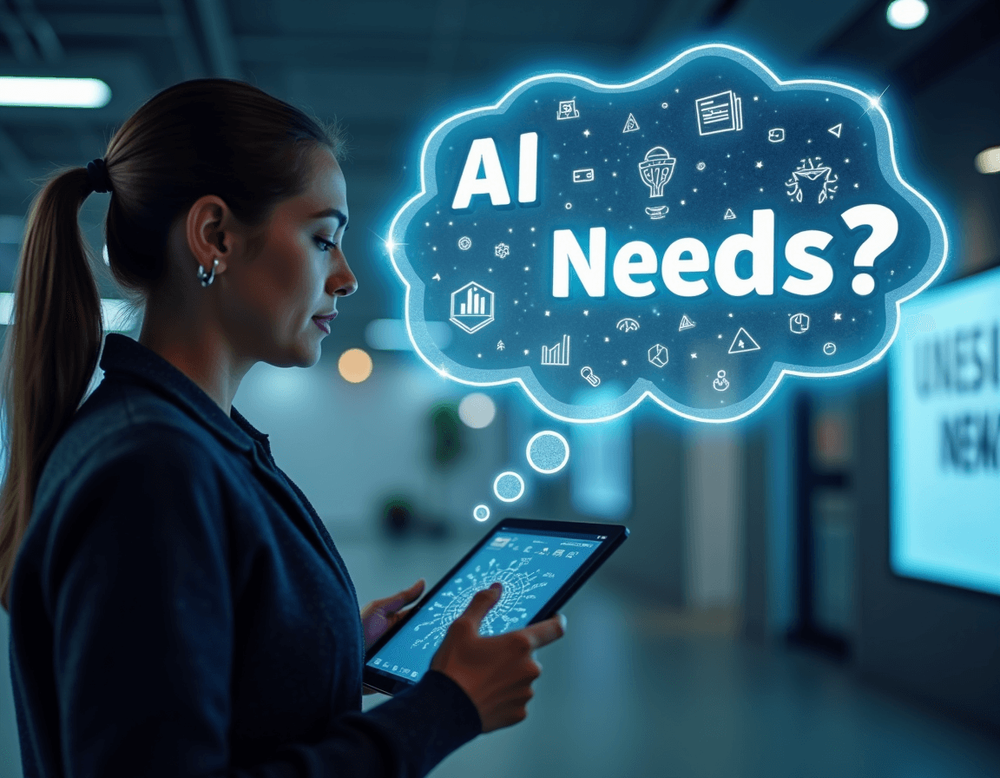The AI Talent Race: A Double-Edged Sword for the Tech Industry
By Matthew Johnson 2025-03-11
The Wall Street Journal's recent article, "How the AI Talent Race Is Reshaping the Tech Job Market," provides an important look at the evolving technology employment landscape. While the piece offers valuable insights, a deeper examination reveals significant challenges and broader implications of this AI-driven shift that demand critical discussion.
The AI Skills Imperative: A Ticking Time Bomb?
The article correctly emphasizes the skyrocketing demand for AI skills, with nearly 25% of U.S. tech job postings now requiring AI proficiency. This surge underscores AI’s transformative impact across industries. However, are we truly prepared for this rapid evolution? Several pressing concerns must be addressed:
- Skills Gap Widening: The explosive demand for AI expertise risks leaving behind a significant portion of the current IT workforce. Without structured upskilling programs, the gap between AI specialists and traditional IT professionals will widen, leading to job displacement and industry instability.
- Superficial Hiring Practices: As companies scramble to acquire AI talent, there is a growing risk of prioritizing buzzwords over real expertise. This hiring frenzy may dilute the quality of AI applications, leading to inefficient or even harmful implementations.
- AI Over-Specialization: While AI expertise is crucial, an overemphasis on AI-centric roles could erode foundational IT skills that remain essential for business continuity and security.
AI's Cross-Industry Expansion: Are We Ready?
The broad adoption of AI across sectors such as retail, healthcare, and finance underscores its versatility. However, are these industries adequately prepared for AI’s integration? Several key concerns arise:
- Cultural and Operational Readiness: Many legacy industries lack the digital infrastructure and organizational agility required to seamlessly incorporate AI. The clash between traditional workflows and AI-driven automation could result in inefficiencies, resistance, and suboptimal outcomes.
- Ethical and Regulatory Blind Spots: AI’s expansion into sensitive areas like healthcare, legal, and finance raises significant ethical and regulatory questions. Are companies adequately prepared to manage AI biases, ensure transparency, and address compliance challenges?
- Security Risks: As AI adoption accelerates, cyber threats targeting AI-driven systems are likely to rise. Are businesses investing enough in AI security to protect sensitive data and mitigate emerging risks?
The ChatGPT Effect: Hype or Paradigm Shift?
The article credits ChatGPT’s launch as a pivotal moment for AI in the job market. While generative AI is indeed a game-changer, a measured perspective is necessary:
- Overemphasis on Generative AI: While ChatGPT has popularized AI, its dominance in discussions may divert attention from other critical AI domains like reinforcement learning, symbolic AI, and traditional machine learning.
- Short-Term vs. Long-Term Viability: Is the current AI job boom a sustainable trend, or are we witnessing a hype cycle? Companies must evaluate whether their AI investments are strategic or reactionary, ensuring long-term value creation rather than short-lived enthusiasm.
- AI Bubble Risks: The rapid increase in AI hiring and investment bears similarities to past tech bubbles. Could we see an eventual correction, with an oversaturated AI job market leading to job losses and AI project stagnation?
The AI Skills Premium: Economic Disruptor or Talent Trap?
The article touches on the rising salaries and job security of AI professionals, but what are the broader economic implications?
- Salary Inflation and Budget Strains: The aggressive pursuit of AI talent is driving salaries to unsustainable levels. This could lead to cost-cutting measures in other areas of IT, potentially undermining overall business stability.
- Retention Bottlenecks: Companies hoarding AI talent for competitive advantage may inadvertently create a stagnant job market where knowledge sharing is limited, hindering innovation across the industry.
- Global Talent Redistribution: With AI expertise becoming a global currency, companies in developed markets may face increasing competition from international talent hubs, disrupting traditional hiring models.
The Future of Non-AI Tech Roles: A Two-Tiered Workforce?
The article briefly notes that non-AI tech professionals still have opportunities, but this issue demands deeper scrutiny:
- The Marginalization of Core IT Skills: A disproportionate focus on AI could diminish investment in foundational IT skills such as cybersecurity, software architecture, and networking. This could create vulnerabilities in enterprise systems that AI alone cannot address.
- Reskilling and Adaptability: The industry must take proactive steps to reskill existing tech workers rather than treating AI expertise as an exclusive club. Without clear reskilling pathways, we risk creating a divided workforce where AI professionals thrive while others struggle to stay relevant.
- Hybrid Roles and AI-Augmented Work: The future of tech employment may not be AI vs. non-AI but rather hybrid roles where traditional IT professionals leverage AI to enhance efficiency. Are companies and educational institutions adapting fast enough to prepare for this convergence?
Conclusion: A Call for Balanced AI Strategy
The AI talent race is undoubtedly reshaping the tech job market, but it must be navigated with foresight and responsibility. Businesses, policymakers, and educational institutions must collaborate to ensure that AI’s rise does not create unintended economic and social consequences.
To thrive in an AI-driven future, organizations must adopt a holistic talent strategy—balancing AI expertise with foundational IT skills, fostering continuous learning, and addressing ethical concerns. Companies that can integrate AI responsibly while supporting workforce adaptability will be best positioned to lead in this rapidly evolving landscape.
The future of technology employment isn’t just about who can hire the most AI talent—it’s about who can harness AI while ensuring sustainable, inclusive, and forward-thinking workforce development. The industry must rise to this challenge before the AI skills race becomes a runaway problem rather than a transformative opportunity.
About Author
Matthew is at the helm of Johnsons Holdings Group (JHG). He provides steadfast leadership defining JHG's strategic approach to nurturing enterprise, startup, and turnaround ventures.
During Matthew’s tenure as Vice President of Product, IoT at HID Global, he spearheaded the creation of cutting-edge SaaS-based IoT platforms, leveraging secure location tracking and AI-driven analytics to provide superior solutions to customers.
With the successful launch of products like HID Bluzone Cloud and HID Location Services, Matthew’s focus on customer relationship management and mobile application innovation significantly enhanced HID’s IoT offerings. As a team, they consistently delivered value-add solutions, cementing their status as leaders in IoT innovation and product strategy.
Matthew has led a cross-functional team of strategists, designers, technologists, and analytics who are considered leaders in business and strategic product development. As a proven leader, he has provided strategic direction by identifying business opportunities, acquisitions, go-to-market strategies, and assessing emerging trends for clients such as HID Global, Coca-Cola, PNC Bank, Verizon, NFL, Sears, AT&T, T-Mobile, Guess, Gap, Motorola Solutions, State Farm, and more.
He founded the Vibes Media professional services and internal agency named “MSG” or Mobile Solutions Group. At Vibes, he grew the practice from an idea with a few people into a full-service mobile agency serving clients such as Verizon, NFL, PGA, Home Depot, Sears, Beam, and Guess. He managed large-scale P&L and led large, award-winning cross-discipline teams (technology, creative, user experience, and project management).
Major accomplishments include:
- January 2024, HID Recognized as a Leader in 2024 Gartner Magic Quadrant™ for Indoor Location Services
- Developing patented & patent-pending security technologies for HID Global
- Founding Bluvision (sold to HID Global in 2016)
- Founding the Mobile Solutions Group at Vibes Media, Chicago IL
- Leading technology on the largest global account at Razorfish, with a retainer in excess of $40M
- Serving as Head of Content Management Center of Excellence at Razorfish from 2009-2011
Matthew has over 25 years of business, consulting, and technology experience. He specializes in C-Suite consulting, omni-channel marketing strategy, mobile technologies, hardware/electronics design, emerging technology, content management, and digital strategy.
Latest
- Bridging the Gap: How Inventors ...
- The AI Talent Race: A Double-Edg...
- Generative Artificial Intelligen...
- Strategic Analysis: Unlocking th...
- Why Generative AI Often Fails to...
- 5 Must-Know AI News Stories from...
- The AI Agent Revolution: What Li...
- The AI Odyssey: What Nvidia’s St...
- Navigating Business Funding and ...
- Riding the AI Waves: The Evolvin...
- The Future of Business: 6 Ways D...
- Generative AI Revolution: The Ne...
- Review: Generative AI’s Act o1 -...
- AI Investment Trends for October...
- Responding to Geoffrey Hinton: D...
- The Evolving Role of the Technol...
- The Future of Business Strategy:...
- Can Venture Capital Weather the ...
- Enterprise Artificial Intelligen...
- Understanding the EU Artificial ...
Tags
© 2024 JHG Consulting | a Johnsons Holdings Group Company | All rights reserved.






